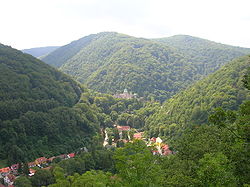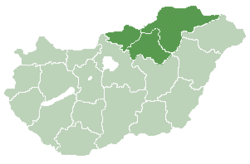| Northern Hungary | |
 | |
Location  | |
| State | Hungary |
|---|---|
| Surface | 13,000 km² |
| Inhabitants | 1.289.000 (2004 estimate) |
| Institutional website | |
Northern Hungary is a geographical region ofHungary on the border with Slovakia.
To know
Territories and tourist destinations
Urban centers
- 1 Aggtelek - Village on the border with Slovakia, famous for the large karst caves inside thepark with the same name.
- 2 Eger - Capital of the province of Heves, Eger is renowned for the production of red wines and its castle, as well as for its thermal baths.
- 3 Gyöngyös - Town of 30,000 inhabitants at the foot of the Mátra mountains, renowned for the production of dairy products and cured meats, as well as wines.
- 4 Hollókő - Ethnographic village, listed by UNESCO as a World Heritage Site. Founded in the 13th century as a military outpost against the Mongol invasion Hollókő, whose name means "Stone of the Crow" was destroyed by the Turks in 1552 together with its castle of which the imposing ruins remain.
- 5 Lillafüred - Small holiday resort in the Bükk mountains, Lillafüred is famous for its luxurious hotel from 1927, built in the style of the Renaissance castles ofHungary, as well as for its green landscapes between waterfalls and small lakes.
- 6 Mezőkövesd - Spa that uses springs discovered in 1938.
- 7 Miskolc - Third city ofHungary, Miskolc is famous for the nearby spa complex of Tapolca with thermal pools inside caves.
- 8 Salgótarján - Close to the border Slovak, Salgótarján is a holiday resort on the hills of Cserhát, covered with lush forests.
- 9 Tokaj - In a picturesque location on the River Tisza (Tisza), Tokaj it is renowned for the production of the wine of the same name, the tokaji “aszú”. The wine-growing region around it is the only one in the world to have the status of world heritage of humanity.
Other destinations
- 1 Miskolc-Tapolca - Thermal caves.

The Domica cave in the park of Aggtelek

Castle of Eger

Traditional costumes Palóc in the ethnographic village of Hollókő

Palace Hotel of Lillafüred
Miskolc-Tapolca thermal baths
How to get


By plane
The airport of Budapest (BUD) (185 km from Miskolc in about two hours by car) is the one with the most flight options. An alternative stopover is that of Debrecen (DEB) (112 km southeast of Miskolc, About 1 hour and 20 minutes by car) where the company wizz air operates flights from Paris-Beauvais, Bergamo (a couple of flights a week), Eindhoven, London-Luton, Malmö, Moscow–Vnukovo and Tel Aviv-Ben Gurion.
The Tisza (Tisza) is the longest tributary of the Danube (1419 km). It is formed by the confluence of the Black Tisza and White Tisza rivers in Ukraine and flows into Romania before entering Hungary. Its water flow varies considerably during the year, so river cruises are not possible during lean periods. Companies that offer boat trips are CroisiEurope (nine days in June alone) e Tokaj Shipping Service[link not working]. The boats of both companies depart from Tokaj and go up the course of the Danube and its tributary Sava in Serbia.
On the train
Intercity trains depart daily every 2 hours from Budapest-Nyugat and Budapest-Keleti stations bound for MiskolcIn Miskolc there are also a couple of InterCity stops a day coming from Košice in Slovakia and directed to Budapest plus other less fast trains.
The via ferrata n. 80 from Budapest, crosses the whole region in the direction of longitude and is completely electrified, including its branch to the border Slovak. The 100 da line is also electrified Debrecen to Zahony, on the border withUkraine. The timetables are available on the website of Hungarian railways (MÁV).
How to get around
What see

_4.jpg/220px-Várrom_(2684._számú_műemlék)_4.jpg)


The north of Hungary boasts many castles mostly in ruins but with a few exceptions:
- 1 Füzér Castle (Füzéri vár). Medieval castle on top of a hill bordering the Slovakia, entirely rebuilt in 2015 and open to the public the following year. His visit should coincide with one of the many events that take place there throughout the year, at Easter, in June (archery costume competition and St. Ivan's night, the closest to the solstice of summer), in mid-July (concerts and medieval poles) and the first weekend of September and October (handicraft market and poles). Füzér Castle is a stop on the tourist circuit known as the "Blue Trail of Hungary".
- 2 Boldogkő Castle (Boldogkői vár). Historic castle completed soon after the Mongol invasion ofHungary and already in ruins at the beginning of the eighteenth century, at the time when it was used by the company of Jesus as a granary. It was renovated in 2009 with funds from the European Union. A small mining museum has been set up there. The castle is beautifully situated on a hill overlooking the village of Boldogkőváralja.
- 3 Andrássy Castle. In the village of Tiszadob.
- Baroque palaces
- 4 L’Huillier-Coburg Palace (L'Huillier – Coburg-kastély). It is the seventh largest palace inHungary. An important example of early Baroque architecture, it was built between 1716 and 1730 by Jean-Francois L'Huillier, a native of France. The subsequent owner of the palace was Prince Ferdinand of Saxe-Coburg and Gotha, lieutenant general of the Austro-Hungarian army. The palace was not used by the new owner and began to decline. It suffered serious damage in 1945, when a Soviet military command settled there and made improper use of the building. For example, a room decorated with remarkable frescoes was used as a chicken coop. Large-scale restorations were initiated in 2001 on the initiative of the national superintendence for historical monuments of theHungary.
- 5 De la Motte Palace. A miniature baroque palace, famous for its frescoes trompe l'oeil that decorate the walls. It is located in the village of Noszvaj less than 6 km from Eger.
Itineraries


- Blue trail of Hungary (Országos Kéktúra) - Part of the European trail E4 which starts at Tarifa in Spain, at the southernmost point of the European continent and develops through France, Switzerland, Germany, Austria, Hungary, Romania, Bulgaria, Greece is Cyprus. The stretch that crosses northern Hungary goes from the Börzsöny mountains to the Zemplén mountains, touching all the main tourist attractions of the region and various youth hostels. There are prizes for those who complete the entire national route, from the border Austrian to that Romanian or one of its three sections. Details on the official site of the route.
What to do
At the table
Safety
Other projects
 Wikipedia contains an entry concerning Northern Hungary
Wikipedia contains an entry concerning Northern Hungary Commons contains images or other files on Northern Hungary
Commons contains images or other files on Northern Hungary






